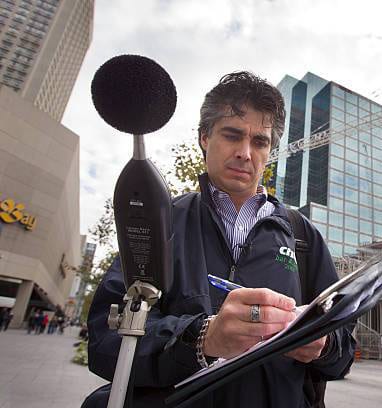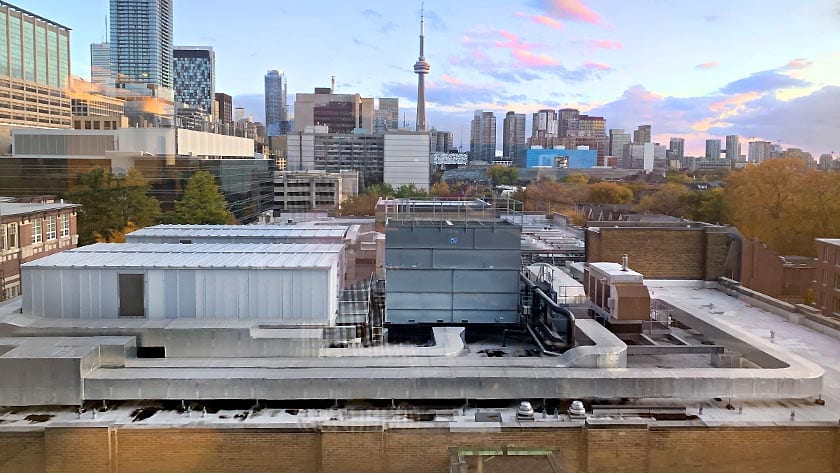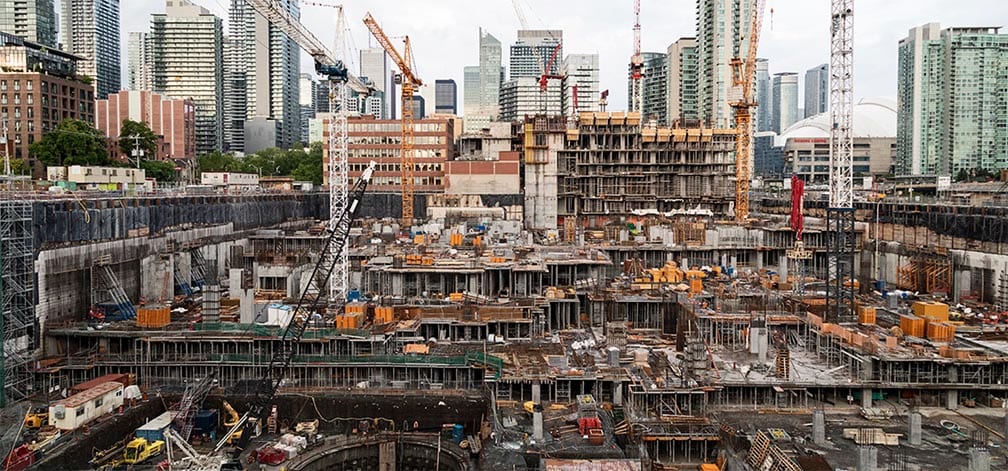Important Updates to the Toronto Noise By-law Impacting Businesses Explained

On October 1st 2019, the City of Toronto implemented an update to its noise By-law (Toronto Municipal Code, Chapter 591, Noise) following several years of consultation among the City, stakeholders and residents.
The updated By-law will significantly affect the operations of noise-generating businesses such as those which utilize “amplified sound” systems (nightclubs, bars, restaurants, fitness centres, etc.), operations with “stationary sources” (refrigeration and HVAC equipment; cooling towers, generators, exhaust fans etc.) and companies responsible for construction site activities in the city.
This article provides a review of the most significant changes relevant to businesses, and summarizes the new responsibilities that owner/operators need to be aware of to ensure compliance with the By-law. To understand the decibel terms dB(A) and dB(C) that are referenced in the By-law and in this review click here.

Here are the Key Highlights of the City of Toronto Noise By-law Updates:
These are the revisions for businesses to note within the updated Noise By-law that we will expand on further in this post:
- Businesses with amplified sound now need to meet the higher of the specific decibel limits (45 dB(A) and 60 dB(C) from 11 pm to 7 am, 50 dB(A) and 65 dB(C) from 7 am to 11 pm) or the measured ambient sound levels at the neighbouring points of reception;
- There is now no subjective/qualitative limits for amplified sound, i.e. there is no restriction on the “audibility” of amplified sound at a point of reception, assuming the decibel limits are not exceeded;
- “Stationary sources” that have approval to operate from the Province now also have approval to operate from the City by default;
- The new By-law now defers to the noise limits provided in the most up-to-date Provincial noise guidelines for “stationary sources” of noise;
- Continuous pouring of concrete and large crane work is no longer permitted outside of the daily work hours listed in the By-law without an exemption permit supported by analysis from a Professional Engineer or acoustical consultant.

What I Need to Know if I am a Business that Features “Amplified Music” (Nightclubs, Bars, Restaurants, Fitness Centres)
The most significant change to the regulation of amplified sound is the switch from qualitative criteria to quantitative criteria, or in other words, from subjective “audibility” by a person to hard-and-fast decibel limits. And this has far-reaching consequences.
The City of Toronto regulates noise from entertainment facilities such as nightclubs and bars via restrictions to the amplified sound levels (i.e., the sound generated by an amplified sound system with loudspeakers). The recent surge in construction of mixed-use buildings throughout the city has also resulted in the positioning of restaurants and fitness centres, which play loud, rhythmic music, within condominium buildings, meaning these businesses are also subject to the Noise By-law.
The old By-law stated “music should not be clearly audible at any residential receptor”, and “music should not be projected beyond the lot line of the property from which the noise emanates and into any street or public place”. The By-law was therefore based on the audibility of an amplified sound system by a person within a residence, and the subjective determination of whether sound is being “projected” into a public place. There were no numerical decibel limits to assess or measure an entertainment facility.
With the updated By-law, the City has eliminated the subjective criteria by introducing quantitative decibel limits. In other words, it will not matter if amplified sound is audible at a point of reception, but rather the sound level impact will need to meet a defined set of decibel limits, as follows; “no person shall emit or cause or permit continuous amplified sound that, measured with a sound level meter at a point of reception in an indoor living area, has a sound level (expressed in terms of LEQ for a ten-minute period), exceeding 45 dB(A) or 60 dB(C) from 11 pm to 7 am, or 50 dB(A) or 65 dB(C) from 7 am to 11 pm.”
Further, in areas of the city where the acoustic environment is consistently “noisy” (e.g. close to busy roadways), the existing ambient noise will now be factored-in. The new By-law has addressed the already “noisy” sections of the city, to account for the “masking” potential of an already noisy environment, by adding a provision stating “despite the specific prohibitions for amplified sound (i.e., the limits) where the ambient sound level at a point of reception exceeds the maximum sound level under those subsections, no person shall emit or cause of permit continuous amplified sound that, when measured with a sound level meter at a point of reception, has a sound level (expressed in terms of LEQ for a ten-minute period) that equals or exceeds the ambient sound level”. In other words, if the existing ambient sound levels are consistently greater than the decibel limits listed above, the ambient level becomes the limit.
Also of significance – while the By-law includes a new section 591-2.9 to govern “Unreasonable and persistent noise”, amplified sound is exempt from this section, further enforcing the new quantitative approach of the City.
In most cases, the changes will be considerably less restrictive for businesses operating amplified sound systems. It will now be permissible for bars, nightclubs, restaurants, fitness facilities, etc. to leak amplified music into public spaces, and/or to be considered “audible” at a point of reception, without fear of penalty, so long as the decibel limits are met. From our experience assessing the amplified sound of more than 100 venues within the City under the old By-law, this update represents a substantial relaxation of the requirements for businesses.

What I Need to Know if my Business Includes “Stationary Sources” of Noise ( Refrigeration and HVAC Equipment; Cooling Towers, Generators, Exhaust Fans etc.)
The updated By-law contains two fundamental changes which impact the restriction of noise from what the City refers to as “stationary sources” As mentioned earlier these “stationary sources” include facilities that operate refrigeration and HVAC equipment; cooling towers, generators, exhaust fans etc. In addition, businesses that involve routine vehicle loading and unloading such as supermarkets, warehouses and assembly plants are also deemed to be “stationary sources”.
The new By-law now defers to the noise limits provided in whatever is the most up-to-date Provincial noise guidelines for “stationary sources” of noise. This is achieved by avoiding reference to a specific Provincial Noise Pollution Control (NPC) document, and by simply stating “No person shall cause or permit the emission of sound from a stationary source … has a sound level exceeding 50 dB(A) or the applicable sound level limit prescribed in provincial noise pollution control guidelines”. The old By-law had referenced the specific guideline NPC-205, which had been superseded by the Province with NPC-300 in 2014, meaning stationary sources needed to meet different limits from two separate guidelines, which created unnecessary confusion and conflicting compliance mandates. This discrepancy has been resolved with the updated wording in the new By-law.
Perhaps more importantly, the new By-law directly states that, if a stationary source is in compliance with a Provincial Environmental Compliance Approval (ECA) it thereby also meets the requirements of the By-law. Typically, when a facility has a valid ECA, the noise emissions have been assessed by an acoustical consultant, and the Province has scrutinized the assessment and issued the ECA. In addition, in special circumstances, a facility may have an ECA despite not meeting the limits in the NPC Guideline. This occurs when the facility is in the process of implementing noise control measures to reduce noise levels. Therefore, this added provision will allow a stationary source to temporarily “exceed” the decibel limits, assuming the Province has granted an approval.

What I Need to Know if I am Responsible for Construction Site Activities
The most significant change associated with the construction noise section is the removal of an exemption which previously allowed the continuous pouring of concrete and large crane work outside of the permitted work hours listed in the By-law. Similar to the old By-law, the updated version restricts noise-generating construction activities to the hours of 7am though 7pm on weekdays and from 9am to 7pm on Saturdays. Construction noise is outright prohibited on Sundays and Statutory holidays. In the past, real estate developers and construction companies utilized the exemption on a regular basis, considering concrete pouring operations cannot be interrupted once they have started, thus the removal of this exemption may interrupt the typical day-to-day operations of construction teams.
Article 3 of the updated By-law, “Exemptions”, addresses this issue; the City will allow concrete pouring and large crane work outside of the permitted hours if an exemption permit is sought by the constructor, and subsequently granted by the City. Specifically, in relation to noise, the constructor will need to develop a “noise mitigation plan” and provide “a statement certified by a professional engineer or acoustical consultant for any sounds that are not technically or operationally feasible to control” in order get the exemption permit.
The City has not provided additional details regarding the technical requirements of a “noise mitigation plan” and has not explicitly stated that an acoustical engineer/consultant is required during the development of the mitigation plan. However, the City may be heading in this direction, or may even require long-term noise monitoring campaigns, similar to the Construction Vibration Assessments that the City currently requires for construction close to existing buildings. While it remains to be seen how cautious and/or rigorous the City will be when reviewing an exemption application, should the need arise, HGC Engineering can provide assistance with determining feasibility, and the design of mitigation.
